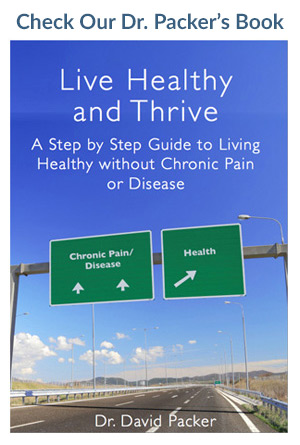 When you are in pain, trying to achieve good health and weight loss can sometimes make you feel like you are between a rock and a hard place. On the one hand, you are told you need to lose weight for better health. However, on the other hand, you feel too poorly to exercise for weight loss.
When you are in pain, trying to achieve good health and weight loss can sometimes make you feel like you are between a rock and a hard place. On the one hand, you are told you need to lose weight for better health. However, on the other hand, you feel too poorly to exercise for weight loss.
As a chiropractor in the Chesapeake region of Virginia for more than two decades, I have had many patients who have come to me in pain and needing weight loss. In this article, I will share some of my tips for losing weight while in pain.
It is important to remember that my suggestions here are general ones: your specific medical condition may require a more tailored approach. Please consider calling my office to make an appointment if you need more information.
Deconditioning: A Major Cause of Back Pain
Deconditioning refers to changes that take place in your body when you are inactive. These changes can be in your muscles as well as organs like your heart and lungs. When you are deconditioned, you may have trouble with a wide range of activities. In mild cases, a person may feel deconditioned when they try to exercise after being inactive. In severe cases, a person may be so deconditioned that they even have problems with self-care at home.
Deconditioning is closely linked to back pain. Unfortunately, when someone is in pain, they often avoid exercise, leading them to become even more deconditioned, and causing worsened pain. Other symptoms of deconditioning include:
- Weakness
- Fatigue
- Pain
- Shortness of breath with exertion
- Uncomfortably fast heart rate with exertion
- Decreased strength, balance, and endurance
The way to fix deconditioning is by increasing your physical activity to build up your strength and health. This is because exercise stimulates the healing process. Even if it is difficult to think of exercising when you are in pain, this is the way to overcome deconditioning and avoid your pain getting worse. This is especially true because deconditioning is also linked to weight gain, which independently is also linked to back pain.
How Does Exercise Help Your Spine?
Exercise helps your spine and can relieve your back pain in several different ways:
- Exercise stretches, repairs, and strengthens muscles that support the back, including your core muscles in your back and abdomen. When these muscles are strong and healthy, your pain improves.
- Exercise and stretching improve your flexibility in your muscles, tendons, and ligaments. This lessens the pressure in your back, relieving pain.
- Exercise gently squeezes the intervertebral discs in your spine. This allows them to exchange fluids, which is how they get their nutrition, and reduces swelling.
The Best Exercises When You Are in Pain
Exercise does not need to be overwhelming. The goal of exercising when you are in pain should not be to work through the pain, but to work around the pain. Effective programs can include low-impact walking and stretching. Some of the best exercises when your back hurts include:
- Walking or swimming, which are low-impact exercises that benefit both your muscle strength and your cardiovascular system. Make sure to stretch to warm up your muscles before exercise to avoid irritating your muscles.
- Stretching to maintain your strength, posture, and flexibility
- Strengthening exercises to increase your muscle mass in your back and abdomen
- Keeping a good posture to strengthen your core muscles
When to Stop Exercising When You Are in Pain
Even though overcoming your deconditioning is important, in some cases your body will send you a message to stop exercising. This includes acute or worsening pain: if an exercise triggers increased pain, you should avoid that specific exercise and tell your doctor. In addition, you should contact your doctor if you experience any of the following:
- Your weakness and fatigue increase over time, instead of improving
- Your endurance worsens over time, instead of improving
- You feel lightheaded when moving from a lying to sitting position, or from a sitting to standing position
In addition, you should seek immediate medical attention if you experience chest pain, extreme shortness of breath, or if you faint.
Incorporating Exercise Into Your Treatment Plan at Precision Spinal Care
As a certified NUCCA chiropractor and spine management physician, I make sure to evaluate the root cause of your condition before coming up with a treatment plan. This includes any suspicion of deconditioning and problems with strength and flexibility. If your treatment can be enhanced by exercise, I will fully educate you on the best and safest stretches to perform to optimize your back health.
To accomplish this, during your first visit, I will do a thorough examination of your spine. Afterwards, I will go over my evaluation with you in detail. Together, we will set reasonable expectations and milestones for recovery and further evaluation. We will also put together a treatment plan that meets your care needs. I will reevaluate you to make sure you are meeting your goals.
My experience and expertise in spinal biomechanics allow me to competently and safely address your back issues. I am a trauma and hospital-qualified spine management physician. I have credentials in MRI spine interpretation, spinal biomechanical engineering, and orthopedic testing through the Academy of Chiropractic. I am also a fellow in Spinal Biomechanics and Trauma which is recognized through the SUNY Buffalo Jacobs School of Medicine.
If we determine that chiropractic is not the best solution for your needs, I will recommend the type of specialist who is most appropriate for you. I may also recommend other specialists that can be used in conjunction with chiropractic care to help you meet your needs.
We understand that you need to explore all your options when you are trying to treat your pain. At Precision Spinal Care, we are happy to help you determine the best way to address your specific needs and discuss all the options with you and your family.
Call our office at (757) 382-5555 to speak to the doctor or set up a consultation. You can also set up an appointment online here.

